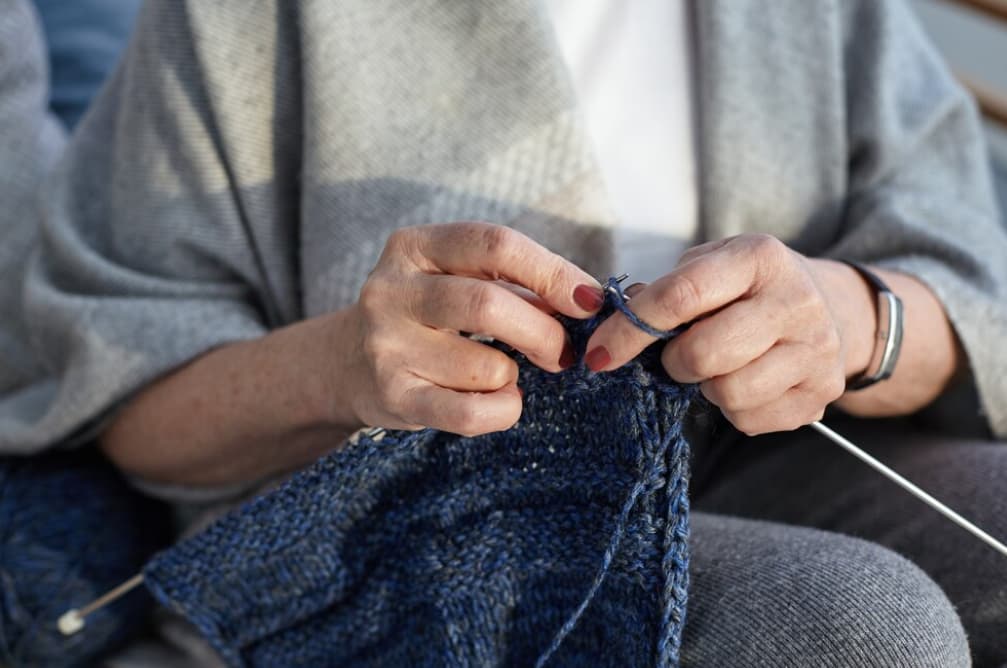A Beginner’s Guide to Knitting
Explore the basics of knitting through an easy-to-follow guide on the continental method. Perfect for beginners, this guide covers all the crucial techniques you need for your first project. Whether you’re just starting out or thinking of switching to continental knitting, this guide is packed with detailed steps, clear images, and instructional videos, making it an excellent tool for anyone new to knitting. Once you’ve got a handle on the essentials, we can advance to a more specialized skill: German short rows, a key technique for introducing shape and complexity into your knitting creations.
Now, let’s begin the journey into knitting with a straightforward approach.
Cast-On Technique in Knitting
Starting your knitting adventure begins with a basic yet crucial step: casting on, which involves creating initial loops on your needles. This step is akin to laying the foundation for a building.
There are about 50 different cast-on methods in knitting. For beginners, the longtail cast-on method is recommended. It’s chosen for its flexibility, ease, and adaptability after some practice. In contrast, older guides may suggest starting with the single cast-on method, which is simpler but results in a less flexible edge that can make knitting the next rows more challenging.
- Step 1: Wind the yarn around your pinky finger twice, moving clockwise. Keep the yarn ball to your left, leaving a tail about four times the width of your intended project. For a 10-inch wide scarf, for instance, leave a 40-inch tail;
- Step 2: Run the yarn across the back of your hands;
- Step 3: Twist your hand and loop the yarn around your thumb clockwise;
- Step 4: Tuck the tail between your ring and pinky fingers;
- Step 5: With a knitting needle in your right hand, pass it under the thumb loop. Use two needles together for more give;
- Step 6: Hook the yarn from behind, close to your index finger;
- Step 7: Draw this yarn through the thumb loop;
- Step 8: Remove your thumb from the loop;
- Step 9: Tighten the loop by spreading your thumb and index finger apart;
- Step 10: Pull the right needle towards you, creating a “slingshot” shape;
- Step 11: Continue these steps until you’ve cast on the needed number of stitches.
Aim for even and consistent stitches, avoiding large gaps.
Tip: As a practice run, try casting on 20 stitches using 5.00 mm needles and DK cotton yarn for a small piece. The number of stitches might vary based on your yarn’s thickness, so check the yarn label for the appropriate needle size for your yarn type.
Learning the Basics: Knitting the Knit Stitch
After successfully casting on the required stitches, the next skill to acquire is the knit stitch. This isn’t much more challenging than the cast-on technique.
- Step 1: Rotate the knitting needle so that the small tail hangs on the right side;
- Step 2: Loop the working yarn, connected to the ball, around the left hand’s pinky finger twice (or once if it restricts yarn flow);
- Step 3: Guide the yarn across the back of the hand once more;
- Step 4: Grasp the needle with the cast-on stitches as one would a knife. Ensure the yarn linked to the index finger is tight. If not, readjust the grip or tighten the yarn;
- Note: The working yarn should be at the needle’s lower back. Double-check its position, ensuring it’s not looped incorrectly from the front;
- Step 5: Hold the second needle in the right hand, similar to holding a knife;
- Step 6: Insert the right needle into the first loop on the left needle from left to right, sliding stitches closer to the needle’s tip if needed;
- Step 7: Wrap the yarn around the needle counter-clockwise, starting from behind;
- Tip: Imagine the needle as a clock’s center; from an overhead view, the yarn should circle counter-clockwise;
- Step 8: Thread the yarn through the first loop, using the left index finger as a guide;
- Note: As knitting needles lack hooks, angle the right needle horizontally to prevent yarn slippage while pulling through;
- Step 9: Let the first loop fall off the left needle. Tighten the newly formed knit stitch on the right needle;
- Step 10: Repeat steps 6-9 for all stitches on the left needle, keeping the working yarn at the needle’s back.
The process remains consistent: insert from left to right, capture the yarn from behind, pull through, release the loop, and secure the stitch.
Starting the Second Row in Knitting

In knitting, you build up your fabric by adding rows of stitches onto a needle. Once you’ve completed one row, you move on to the next by flipping your work. Knitting generally goes from right to left, so it’s vital to reposition your yarn properly. Turn your needle in a clockwise direction to ensure the yarn is placed correctly. Keep an eye on the tension of the yarn you’re working with, making sure it’s not too loose or tight, and that it doesn’t create unintended loops or tug at the initial stitch too much.
As you continue, knit through each loop on the row. When you reach the end of a row, flip your work again. This repeated turning and knitting creates what is known as Garter Stitch, a basic knitting pattern.
Every piece of knitting has two different sides: the ‘right’ side, which is usually the side you started on, and the ‘wrong’ side, typically the even-numbered rows or the rows you do on the way back.
For those keeping track of their work, counting the rows in a Garter Stitch pattern is quite easy and follows a specific technique.
Joining a New Ball of Yarn
Eventually, the yarn may run out, necessitating the addition of a new ball. This is a simple process:
- Complete knitting a row, leaving a short tail of about 5 inches for later weaving;
- Create a simple knot with the new yarn around the tail of the old yarn, again leaving a short tail;
- Position the knot at the base of the first stitch;
- Continue knitting with the new yarn as before.
Correcting Knitting Mistakes
Mistakes in knitting, such as dropping stitches, can occur but don’t require starting over. These can be corrected using a crochet hook.
Counting Knitted Rows
To determine the number of completed rows in a Garter Stitch, count the ridges. Each ridge, characterized by a cup-like and a dome-like bump, represents two rows.
How to Perform a Bind-Off in Knitting
In the world of knitting, it’s essential to know how to complete your project properly. You’ve learned the art of knitting, but simply putting away your needles won’t suffice. If you were to do that, all your diligent efforts would come undone! This is where the technique of binding off or casting off comes into play. The process involves securing the stitches on your needle, and it is known by either term, bind-off or cast-off. Below are the steps to accomplish this:
- Step 1: Execute two regular knit stitches;
- Step 2: Insert the left needle into the second stitch on the right needle, moving from left to right;
- Step 3: Raise the second stitch over the first;
- Step 4: Release it from the needle, while the first stitch remains on the right needle;
- Step 5: Perform one more knit stitch;
- Step 6: Lift the newly formed second stitch over the first and remove it from the needles;
- Step 7: Continue repeating steps 5-6 until only one stitch remains;
- Step 8: Cut the yarn, and employ your knitting needle to pull out the last stitch;
- Step 9: Tug on the tail to tighten it securely.
The Final Step: How to Weave in Ends

Beginning your knitting adventure, it’s vital to master a key skill right from the start. Why is this essential? In almost every knitting project, you’ll end up with two loose ends – one from where you started (cast-on) and one from where you finished (bind-off). Cutting these ends off immediately isn’t an option, as it would cause your knitting to come undone.
Learning how to weave in these ends is crucial.
- Step 1: Thread the loose end through a pointed tapestry needle;
- Step 2: Carefully navigate between two knit ribs and guide the needle through the gaps in the knit, lightly piercing the yarn. Follow the natural curve of the stitches, weaving in for about 6 to 8 stitches;
- Step 3: Draw the yarn through, stretch the fabric to even out, and snip off any extra yarn.
Conclusion
Congratulations! The skill of knitting is now within your grasp. What lies ahead? It’s time to acknowledge your accomplishment. Take a moment to commend yourself. Even if your initial swatch appears a bit irregular, don’t dwell on it. Instead, place it in your personal keepsake box as a reminder of the day when you mastered this remarkable hobby.
Both your mind and muscles need time to become acquainted with these new movements. After you’ve knitted a few thousand stitches, these actions will become second nature. You won’t need to meticulously deliberate over the minute finger movements any longer. However, this progression takes time. At the outset, knitting may feel akin to juggling fragile eggs. Numerous aspects demand your attention simultaneously. Yet, with practice, you’ll perform these actions effortlessly. In fact, proficient knitters (like experienced individuals) can knit without even glancing at their needles.
From there, you’ll be just a short step away from mastering the art of knitting socks, hats, or even sweaters. Remember to proceed at a measured pace, take breaks, and avoid overwhelming yourself.
